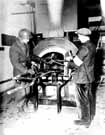
|
|
|

|

|

|

|
|
Click on an image to see a larger, more detailed picture.
|
|
|
|
|
| 1944: Desperate Acts |

|
pg. 575 |

|
|
|
|
| |
 As this picture shows, the Nazis developed an elaborate system for disposal of the bodies of their victims. This American soldier and a member of the French Resistance inspect the crematorium at the liberated camp at Natzweiler-Struthof, France, on December 2, 1944. Notice the tongs, which were used to manipulate the corpses as they were placed in the ovens.
As this picture shows, the Nazis developed an elaborate system for disposal of the bodies of their victims. This American soldier and a member of the French Resistance inspect the crematorium at the liberated camp at Natzweiler-Struthof, France, on December 2, 1944. Notice the tongs, which were used to manipulate the corpses as they were placed in the ovens.
Photo: National Archives/United States Holocaust Memorial Museum Photo Archive
|
 Even after a body is cremated, ashes remain. This presented a problem for the perpetrators of the Holocaust, especially when one considers the sheer number of their victims. Pictured here is a member of the French Resistance, who inspects some of the urns that the Nazis used to bury their victims' ashes in the Natzweiler-Struthof camp.
Even after a body is cremated, ashes remain. This presented a problem for the perpetrators of the Holocaust, especially when one considers the sheer number of their victims. Pictured here is a member of the French Resistance, who inspects some of the urns that the Nazis used to bury their victims' ashes in the Natzweiler-Struthof camp.
Photo: National Archives/United States Holocaust Memorial Museum Photo Archive
|
|
Dora-Mittelbau/Nordhausen Constructed as a subcamp of the Buchenwald concentration camp, Dora-Mittelbau, located near the town of Nordhausen in eastern Germany, became an independent camp in the fall of 1944. Beginning in 1943, thousands of prisoners were assigned to Dora to expand the tunnels of an old salt mine buried deep in the Harz Mountains. They built an underground factory that produced the secret V-1 and V-2 rockets. Human life meant nothing in the Nazis' quest to turn the tide of war and avoid defeat. Even by concentration-camp standards, prisoners in Dora were treated brutally by their captors. They spent their lives with no glimpse of the sun and with no sanitary facilities, laboring until they dropped. Bodies, covered in lice and often weighing only 80 pounds, were returned to Buchenwald for burning at the rate of about 1000 a month. Once completed, the factory that manufactured the rockets --the state-owned Mittelwerk GmbH--used thousands of prisoners as laborers, including many Jews. They too labored under dismal conditions, drinking their water from leaks in the pipes. Fear of sabotage provided the pretext for guards to employ extraordinary sadism, hanging prisoners or torturing them on a whim. Untold thousands died at Dora and on death marches from the camp in the closing days of the war.
|
|

|

|

|

|
 December 1944: Liberated France has a "Week of the Absent" to commemorate innocents still in the hands of the Nazis.
December 1944: Liberated France has a "Week of the Absent" to commemorate innocents still in the hands of the Nazis.
|
 December 1944: American pollster Elmo Roper warns that antisemitism has infected the U.S., most strongly in and around cities.
December 1944: American pollster Elmo Roper warns that antisemitism has infected the U.S., most strongly in and around cities.
|
 December 11, 1944: Jewish slave laborers at Auschwitz III (Monowitz-Buna) quietly celebrate Chanukah.
December 11, 1944: Jewish slave laborers at Auschwitz III (Monowitz-Buna) quietly celebrate Chanukah.
|
 December 16, 1944: Along a 40-mile front in Luxembourg's Ardennes Forest, 300,000 German troops comprising the Fifth and Sixth Panzer armies launch a surprise offensive against the American First and Ninth armies. Inexperienced, front-line American troops are overwhelmed as the Germans gamble everything in a bid to seize the strategic port of Antwerp, Belgium. Because of early German gains that create a bulging salient in the American lines, the action comes to be known as the "Battle of the Bulge"; See December 26, 1944.
December 16, 1944: Along a 40-mile front in Luxembourg's Ardennes Forest, 300,000 German troops comprising the Fifth and Sixth Panzer armies launch a surprise offensive against the American First and Ninth armies. Inexperienced, front-line American troops are overwhelmed as the Germans gamble everything in a bid to seize the strategic port of Antwerp, Belgium. Because of early German gains that create a bulging salient in the American lines, the action comes to be known as the "Battle of the Bulge"; See December 26, 1944.
|
|
|
|
|
| 1944: Desperate Acts |

|
pg. 575 |

|
|
The Holocaust Chronicle
© 2009 Publications International, Ltd.
|
|
